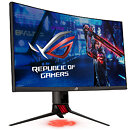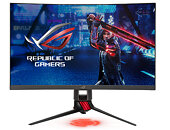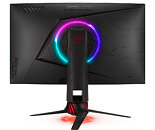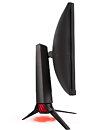Tuesday, March 31st 2020

ASUS Outs ROG Strix XG27WQ: 27-inch 1440p Fast Curved Monitor
ASUS rolled out the ROG Strix XG27WQ, a 27-inch curved gaming monitor. With a 1500R curvature, this monitor offers WQHD (2560 x 1440 pixels) resolution through a VA panel. Boosting its gaming chops are 165 Hz refresh-rate, 1 ms (GTG) response time, ELMB (ASUS extreme low motion blur), and AMD FreeSync Premium Pro certification. The panel meets DisplayHDR 400 specs and supports HDR-10. Other vital panel specs include 178°/178° viewing angles, 3000:1 contrast ratio, and 125% sRGB / DCI-P3 92% color saturation.
The ROG Strix XG27WQ features ASUS' typical tripod base with an ROG logo projection, with height-, swivel-, and tilt adjustments. Display inputs include a DisplayPort 1.2a and two HDMI 2.0 ports. A 3.5 mm headphones jack puts out digital audio from the graphics card. There's also a 2-port USB 3.0 hub. Among the gamer-specific features are ASUS GamePlus suite, which includes hard crosshairs, timer, FPS counter, and display alignment; ASUS GameVisual, a set of game genre-specific display presets; and low blue-light mode. ASUS didn't reveal pricing.
The ROG Strix XG27WQ features ASUS' typical tripod base with an ROG logo projection, with height-, swivel-, and tilt adjustments. Display inputs include a DisplayPort 1.2a and two HDMI 2.0 ports. A 3.5 mm headphones jack puts out digital audio from the graphics card. There's also a 2-port USB 3.0 hub. Among the gamer-specific features are ASUS GamePlus suite, which includes hard crosshairs, timer, FPS counter, and display alignment; ASUS GameVisual, a set of game genre-specific display presets; and low blue-light mode. ASUS didn't reveal pricing.




19 Comments on ASUS Outs ROG Strix XG27WQ: 27-inch 1440p Fast Curved Monitor
1440p, ELMB (of which just a handful of monitors exist), variable sync, good refresh rate. The only meh is the curve. And probably pricing as it carries a STRIX sticker. But this will get copied, and THOSE copies are gonna be interesting :) Just a few years back this set of specs was considered state of the art.
I still don't understand RGB lighting on the BACK of some monitors these days. My Aorus monitor has it, and all I can say is "why?" :wtf: Other than that, it's a great monitor.
This is exactly what motion blur reduction is supposed to do. Eliminate image persistence that is common to LCD. Most color transitions are actually immediately pushed to 100% black. Which is a FAST transition, especially if the same frame has no other information.
Here's what I'm looking at for the past four or five years. Still no urge to upgrade really
gaming.eizo.com/wp-content/uploads/file/turbo240_whitepaper.pdf
Now, what ELMB tries to achieve, for those who are unfamiliar; it does what the above whitepaper shows, but not at a fixed rate, but at the same variable refresh rate as whatever the game is running at. My panel runs it at fixed rate, so when I dive down in FPS, it becomes noticeable. Still very usable, but suboptimal. The smoothness will go away at somewhere around 60-70 FPS, whereas with a normal panel you might have a similar feeling when it runs at say 50 FPS. It gets a little choppy.
BFI is highly underappreciated for most, but once you got it, and you don't have a problem with flickering (part of that is your own physique some people can see the same flickering when they look at headlights and traffic lights for example, as they are pulsing light sources), its hard to let it go. Much more so than say Gsync or Freesync... especially if you have a system that can push high FPS.
www.tftcentral.co.uk/reviews/asus_rog_strix_xg438q.htm
Here they were able to get an average response time done to 4.2 ms (spec claim is 4.0) but because of the excessively high overdrive setting, image quality suffered from excessive overshoot.
"Let's focus instead on the intended uses for this monster! With the 120Hz refresh rate and adaptive-sync support, fast PC gaming is a differentiator for this display compared with most other large format displays available. It's great to see high refresh rate support of course, bringing obvious improvements in motion clarity and frame rates compared with 60Hz models. The G-sync and FreeSync support make it suitable no matter what your graphics card choice is for VRR. There is no input lag either which is excellent news. Response times were decent enough on the whole and for refresh rates up to 100Hz in keeping with some of the better VA panels we've tested. There's still some characteristic black smearing present, but it's lower than on some other VA screens and up to 100Hz there's very little overshoot too which was positive. You can run up to 120Hz max if you want, although you need to then use the most aggressive overdrive mode which while it does improve motion clarity quite noticeably, does introduce high levels of overshoot. There are also some colour depth sacrifices to use that upper 120Hz end. Given the high 4K resolution we expect "up to 100Hz" using VRR to be more common for most users. For console gaming the performance is decent too, with reasonable response times, no overshoot and low lag. "
You can eliminate the overshoot by dropping to 100 Hz, but then response time drops to 8.7 ms
Here they claim 1 ms response time ... as tested it's 3 ms
www.tftcentral.co.uk/reviews/asus_tuf_gaming_vg279qm.htm#response_timesMost folks confuse glow with bleed. Bleed is more common in lower priced monitors, rarely seen on quality panels from AUOptronics
www.tftcentral.co.uk/features.htm#backlight
www.tftcentral.co.uk/features.htm#ips-glow
By way of explanation. the difference between Freesync and G-Sync is that G-Sync has a hardware module that provides motion blur reduction and Freesync does not. To obtain parity, Freesync users can select a monitor manufacturer which provides an alternate technogy which nVidia provides via that module. Doing so increases the cost of the Freesync monitor as a result.
That.
The odds are you'll also have to drop the refresh rate to further reduce crosstalk.
Its not an easy trick. But you keep harping on about slow VA response times... that is only true for a few color transitions in the darker hues. The rest is pretty quick, pretty much a match for IPS.
And note, this is an AVERAGE G2G. This includes the usual, single extremely high response time of the slowest transition (which can run into 30-40ms). The other hues are often faster than IPS, especially if you don't want overshoot/ghosting. VA is actually better in that case than the vast majority of IPS displays.